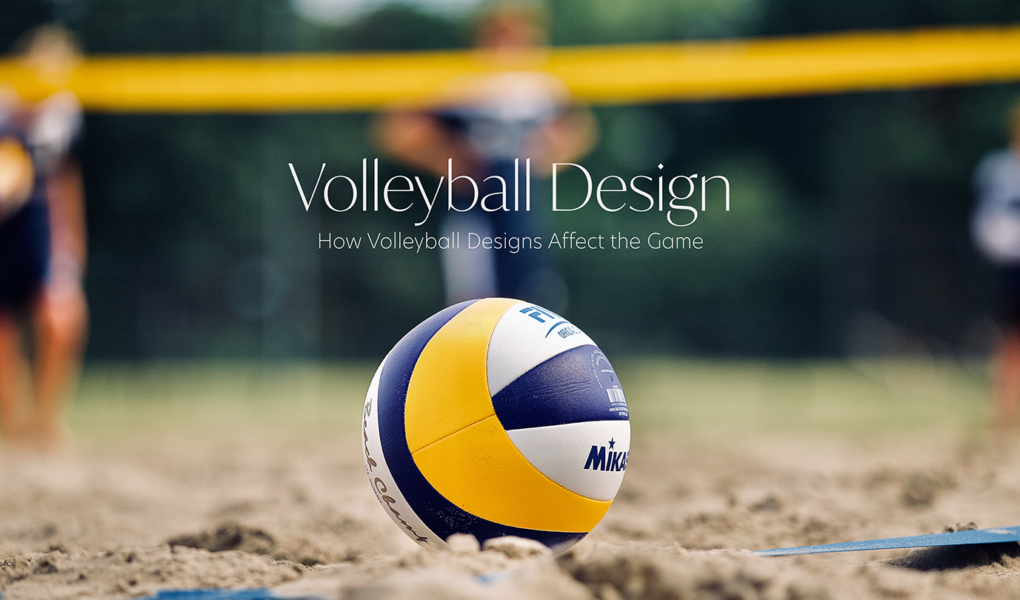Abstract
The design of the volleyball has had many iterations over the years since its creation. The evolution of the ball is not simply an aesthetic change. Traditional volleyballs have six distinct panels and a smooth synthetic leather surface and are still widely used and produced. Newer volleyballs utilize rougher surfaces such as the hexagonal pattern seen on the Molten’s FLISTATEC balls or the dimples on the Tokyo 2020 Olympic volleyball. These rougher surfaces have been shown to directly affect flight patterns. More specifically, the dimples can make the orientation of the volleyball a more prominent factor influencing its trajectory. Changes to the volleyball’s design and their increased unpredictability in trajectory can affect the strategy in games. Certain serve techniques can be made more prominent as they can take advantage of the volleyball’s increased tendency to deviate from their expected paths. This unpredictability makes it extremely difficult for the opponent to receive and can be an effective strategy in the game.
Introduction
As a fan of volleyball, I always thought that the players and the teams were the only factors that influenced the game. Strategy is always based on who the opposing team is, but extra factors are regularly at play. For volleyball, the type of terrain (like sand versus indoor) and the wind are notable factors that would play a role in strategy development, but the design of the volleyball is a hidden force constantly influencing the decisions made in the game.
Numerous balls have been used over the years and there’s a significant amount of research being done on the benefits of new volleyball designs. The adoption of new volleyball designs by volleyball leagues such as the Olympic Committee and the FIVB (the International Federation of Volleyball) is based on research exploring the aerodynamic behavior of the new volleyballs. Traditional volleyballs have six distinct panels and a smooth synthetic leather surface and are still widely used and produced. But how is their effectiveness measured? Sports scientists use wind tunnels to meticulously control the experiment’s air conditions so the designs can be compared with each other accurately.
The measured traits of the balls such as the drag coefficient and the drag crisis point are specific to each volleyball design and directly affect the movement of the ball. The balls used in various international competitions such as the Olympics or the Volleyball Nations League can help teams determine which serves will be more effective during each specific tournament.
The Sport and the Serve
Volleyball is a sport in which two teams consisting of six players compete to prevent the ball from touching the floor on their respective sides of the net. Each team only has three touches to get the ball over before the rally is considered dead and the other team wins the point. The ball cannot be touched twice by one player consecutively. Additionally, the players must rotate across all six positions on the court each time the team regains the right to serve. The type of ball being used impacts all the actions being done during play, but it primarily influences the movement of the serve.

Figure 1: A typical game of volleyball. Original Visual.
There are two popular serves in high-level volleyball play. The jump serve is the most popular and entertaining to watch. This serve utilizes a high point of attack and downward spin to generate a serve that curves down to the ground, making it hard to receive. While this may seem impressive, many professionals as well as amateurs would argue that float serves, the second most popular type of serve, are equally difficult to return. The float serve is a slower-moving serve that flies in the air with little to no spin on the ball. Players can also jump before hitting the ball, creating a similar downward trajectory to the jump serve. However, with the float serve, the ball behaves very differently.

Figure 2: An image of a float serve. Original Visual.
From my experience, a float serve can move almost five feet to either side of its expected trajectory. It’s incredibly frustrating to be well-positioned to receive the serve and extend your arms expecting the ball to hit the right spot only to be disappointed as it shifts away in the last milliseconds, leaving the ball flying crazily away from its intended target. This movement in mid-air (or floating as volleyball players call it) can be influenced not only by technique but the actual ball being used.

Figure 3: Unpredictable behavior of float serves. Adapted from [1]
The Only Drag in Volleyball
In order to understand how a volleyball’s design impacts its flight behavior, I’ll first guide you through some projectile aerodynamics basics. A volleyball’s behavior can be explained by the various forces enacted on the ball in flight. A ball’s interaction with the air surrounding it is quantified by three concepts: the drag/drag coefficient, the Reynolds number, and finally the drag crisis point. Both the drag coefficient and the Reynolds number build up to the most important concept which is the drag crisis point. The drag crisis point determines the volleyball’s unpredictability at certain velocities.
Let’s start with drag. Essentially, a drag force pushes the object in the opposite direction as the projectile travels through a gas or liquid. It’s like when you’re swimming and you feel the water push against your face after every stroke. Because the ball has subtle bumps and patterns on the surface, these forces will not always simply push backward but may push the ball in directions that are diagonal to the flight path of the volleyball. The drag experienced by an object midair is represented by the drag coefficient, and the higher the drag coefficient, the more drag is experienced on the ball’s surface [2]. As volleyball designs vary, the drag on the ball similarly varies as the air will interact differently with different volleyball surfaces.
The Reynolds number is a parameter that quantifies the flow of air past a sphere, and when players serve at various velocities, the amount of flow that passes the sphere changes. The flow of air is dictated by how much air passes the ball in an interval of time, so changing the velocity has a linear relationship with the Reynolds number. The drag experienced by the ball varies depending on the flow of air passing by the ball. So, in order to observe trends in the experienced drag of a volleyball, scientists will measure the drag experienced by the ball in different Reynolds numbers by changing the velocity of the ball’s launch[3]. These studies will typically gather many data points and plot them like in Figure 4. Sports scientists generate these specific air conditions using a wind tunnel, which can control every aspect of the projectile’s environment to eliminate any factors interfering with the validity of their results. Using these methods, scientists can see how drag forces on the volleyballs compare with other volleyball models.

Figure 4: Drag coefficient versus Reynolds number. Adapted from [1].
Now, let’s throw the previous concepts all together into the most significant phenomenon which is the primary aspect of why one volleyball design might act differently from another: drag crisis. The drag crisis is a sudden drop in the drag coefficient at a certain Reynolds number. This drop can be seen very clearly in Figure 4 above. So, at a certain condition (this could be the velocity of the ball or a draft of wind in the air), a drastic drop in drag can occur. This drop in drag occurs because the ball flying in the air switches from turbulent to laminar flow at that range of Reynolds numbers. Minute changes in the volleyball’s design can drastically change the point of this drag crisis. For example, in a study done on soccer balls, it was found that balls with small dimples on their surface experienced a lower drag coefficient in the same range of Reynolds numbers when compared to dimple-less soccer balls. The dimples drastically change the magnitude of the forces acting on the ball in certain conditions, creating variations in the ball’s flight behavior. Therefore, the design of the volleyball can be studied to find a correlation between the type of ball and its behavior in flight. [1]
The Reynolds number at which each volleyball design experiences its drag crisis point is a trait that is highly specific for each individual ball and can vary for each way that the ball is oriented. For example, in many studies, the ball’s orientation affected the drag experienced by the ball. So, the ball flying in a different orientation but in the same air conditions caused the drag crisis point to vary. The orientation plays a factor in how the ball behaves in flight, but different volleyball designs can mitigate the variation in crisis points for different ball orientations. Thus, making the orientation of the ball less influential in ball behavior.

Figure 5: Different ball orientations correlate to different flight behaviors. All three balls are examined in two orientations and all three balls behave differently due to changes in flight orientation. Adapted from [6].
An important aspect of the drag crisis point is that it can be completely avoided if the right conditions are met. College volleyball teams have noticed how volleyballs moving at high enough velocities don’t exhibit unpredictable changes in flight trajectory like slower serves do. The floating effect isn’t seen as often when males play volleyball since they serve with too much velocity to take advantage of the drag crisis. However, in the female game, they typically serve around 15 meters per second, which is the range where the drag crisis can be easily observed [4]. This specific range in which the drag crisis is commonly observed can be extrapolated to other volleyball actions. Most spikes are straight down and spin with too much velocity to notice any erratic movements while other actions like sets and bumps aren’t in the air for long enough periods of time or move too slowly to see any movement mid-flight. Therefore, the floating phenomenon isn’t a noticeable factor for any volleyball actions other than the float serve.
Behavior of Volleyballs Based on Their Differing Designs
As it happens, the ball’s design can be partly to blame for the erratic movement of such serves. There are two primary aspects to the ball that can affect its behavior. One trait is the paneling of the volleyball. Secondly, the surface of the balls can be changed by adding dimples or thin protruding patterns on the surface. These two aspects can drastically affect how dramatically the ball deviates from its expected path, thus possibly increasing or decreasing the efficacy of certain serves. From my own experience, playing with ball c (dimple ball) below in Figure 5 has given me the most frustration in-game when receiving float serves. We’ll explore why.

Figure 6: Ball paneling of three different volleyballs. Adapted from [1].
There are two major ways manufacturers have departed from the traditional six-paneled volleyball. These two ways are to either change the shape and number of panels on volleyball and/or change the surface texture of the volleyball. Two of the most notable ways of changing the surface texture of the volleyball have been to either implement dimples on the ball or to create a hexagonal patterned protuberance on the surface of the ball. Changes in surface roughness can cause more deviations in expected trajectory or increased importance on the ball’s orientation.
The importance of the ball’s orientation during flight is a weird phenomenon. The volleyball’s behavior and drag crisis point is strongly influenced by its orientation during flight. For example, if the ball is oriented straight up and down, it would have a different drag crisis point than if the ball was diagonally oriented. However, the design of the ball can influence to what degree the ball’s drag crisis point deviates due to its orientation. Studies have shown that adding any type of texture to the ball’s surface has shown to decrease the variability in drag crisis point due to ball orientation, making the volleyball more easily controllable for higher-level players [6]. Textured volleyballs tend to have more uniform drag crisis points regardless of the ball’s flight orientation compared to the traditional smooth volleyballs, making the orientation of the ball less influential in the ball’s behavior. So, in tournaments using textured volleyballs, players don’t have to stress about hitting the ball in a specific orientation. This adaptation allows for more easy control of the ball. The reliance on ball orientation is quantified by the ball’s measured drag crisis point when launched in different orientations.

Figure 7: Differing surfaces of volleyballs. Adapted from [6].
The roughness of the surface of the volleyball has been shown to have a strong influence on the ball’s behavior. For example, the increased roughness seen on the hexagon balls demonstrated fewer deviations from their expected trajectories. Dimpled volleyballs, in contrast, exhibited a much larger deviation than both the hexagon ball and the traditional ball [1]. The dimpled volleyballs’ crisis point, for all its orientations, lie within a Reynolds number range very common in professional volleyball, thus making the drag on the ball drop dramatically regardless of its flight orientation. This change in drag explains its increased movement in flight. No wonder the dimpled balls were so much harder to pass!
The surface design of the volleyball also had a significant effect on the distance the balls traveled as the dimpled ball traveled shorter distances than the hexagon ball. This difference was attributed to the lower drag coefficient experienced by the hexagon ball than the dimpled ball at similar Reynolds numbers [6]. Lower drag forces equate to less force pushing the ball, so naturally, less drag would mean farther travel distance for the hexagon ball.
Volleyball Design Changes and Their Implications:
Clearly, the design of the volleyball affects how the volleyball moves, but how does that change the way the game is played? The dimpled volleyball would make float serves more viable and difficult to receive since research has shown the increased horizontal variation movement and deviation during flight [1]. This movement is a dangerous weapon as receivers would struggle to predict the flight path of the volleyball. At the same time, the ball is less dependent on its orientation than other balls, making the orientation of the volleyball one less thing to worry about for servers.
The rougher surface designs of the volleyball seen in the hexagon ball and the dimpled ball both have been shown to decrease reliance on ball orientation in flight, making it easier to control the ball. So, serves at higher speeds can be more reliable in-game, leading to an easier time getting aggressive serves in the court. This would allow teams to implement a more risky serving strategy. For example, the USA Men’s National Team’s serving strategy prioritizes aggressive serves over safe serves under the assumption that more aggressive serves. Though more prone to error, these serves will have a higher payoff than safe and slower serves due to the more controllable nature of the newly designed volleyball.
The serving strategy of international teams can adjust their aggressiveness and increase the prevalence of certain serve techniques in response to the usage of different volleyballs. In this sense, the design of the volleyball is an unnoticed factor for the casual volleyball watcher that, in reality, plays an integral role in the outcome of the match.
References
[1] T. Asai, S. Ito, K. Seo, and A. Hitotsubashi, “Aerodynamics of a new volleyball”, Procedia Engineering, vol. 2, no. 2, pp. 2493-2498, 2010, doi: 10.1016/j.proeng.2010.04.021.
[2] Glenn Research Center, “The Drag Coefficient”, NASA, 2021. [Online]. Available: https://www.grc.nasa.gov/www/k-12/airplane/dragco.html. [Accessed: Sep. 1, 2021]].
[3] ScienceStruck, “What is Reynolds Number and What are its Applications?”, ScienceStruck. [Online]. Available: https://sciencestruck.com/what-is-reynolds-number-what-are-its-applications. [Accessed: Sep 1, 2021]
[4] A. Cho, “In volleyball, crafty players serve up an aerodynamic crisis,” Science (American Association for the Advancement of Science), vol. 306, no. 5693, pp. 42–42, 2004, doi: 10.1126/science.306.5693.42a.
[5] S. Hong, T. Asai, and B. M. Weon, “Surface patterns for drag modification in volleyballs,” Applied sciences, vol. 9, no. 19, p. 4007–, 2019, doi: 10.3390/app9194007.
[6] S. Hong, H. Ozaki, K. Watanabe, and T. Asai, “Aerodynamic characteristics of new volleyball for the 2020 Tokyo Olympics,” Applied sciences, vol. 10, no. 9, p. 3256–, 2020, doi: 10.3390/app10093256.




